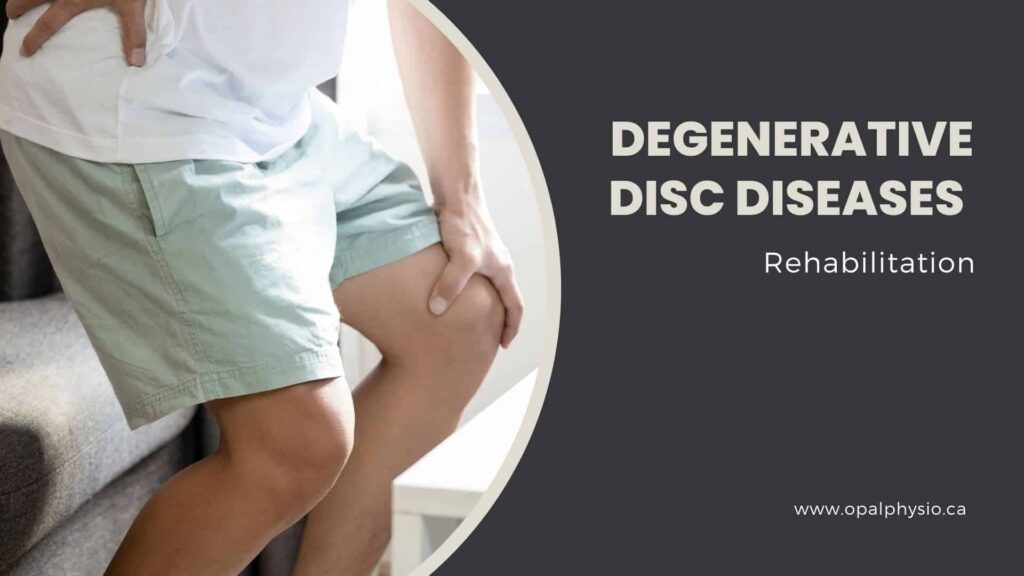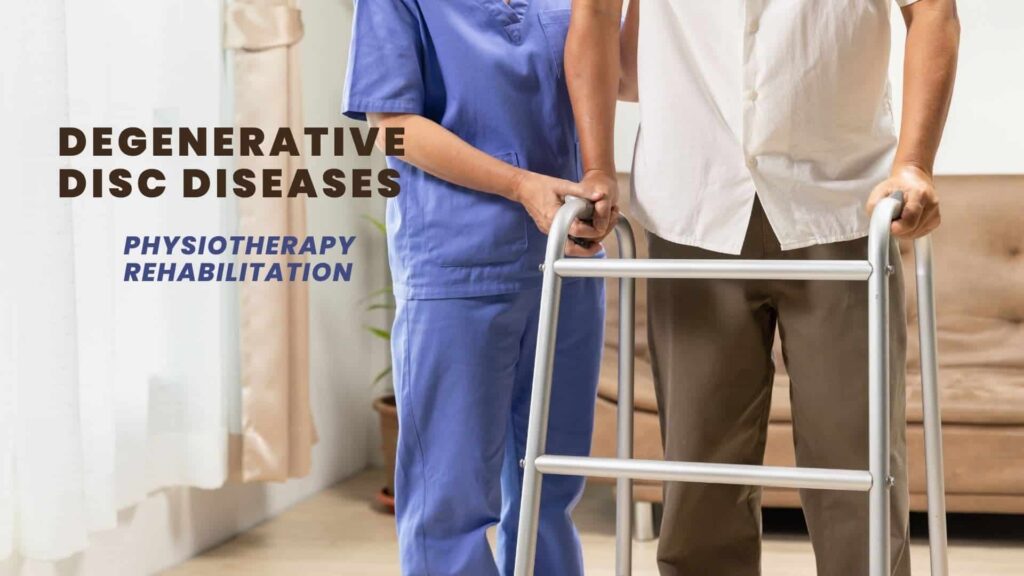Degenerative Disc Disease
Degenerative disc disease is a common condition caused by the deterioration of the discs in between the vertebrae. It can be caused by ageing, injury and even genetics. The pain can be mild to severe and sometimes significantly impact day-to-day activities.
Physiotherapy rehabilitation can be crucial in managing degenerative disc disease and improving the patient’s quality of life. We offer rehabilitation programs tailored to the specific needs and goals of patients. Our physical therapists will evaluate the patient’s condition and develop a personalized treatment plan to optimize function and well-being.

What is a degenerative disc disease?
Degenerative Disc Disease ( DDD ) is a condition that can occur when the discs in the back have lost some of their natural fluid content and become hardened and brittle. This hardening of the discs can lead to a loss in height, narrowing of the spinal canal, and sometimes compression of the nerves.
Degenerative disc disease is a type of wear and tear on the spine. It can cause stiffness in the vertebral joints and can cause pain in the back and neck.
The discs in the spine are made of two parts: a soft center called the nucleus pulposus and a tough outer covering called the annulus fibrosis. The discs allow for flexibility in the spine and act as shock absorbers to help protect the neck or back from injury, like twisting or bending forward and backward.
When you have degenerative disc disease, one or more discs may start to break down, causing them to lose their cushioning effect and become thinner over time, leading to pain, weakness, numbness and tingling sensations. DDD can occur in the cervical( neck), thoracic (upper or mid back) and lumbar spine ( lower back).
Although DDD is usually managed well, the supporting tissues, blood vessels, and nerves can get affected in the longer duration of disc degeneration. This may cause degenerative conditions, like osteoporosis, spondylolisthesis, spinal stenosis, osteoarthritis, and nerve impingement, sometimes leading to more debilitating pain symptoms.
Degenerative disc diseases symptoms:
The signs and symptoms of degenerative disc disease are:
These symptoms can vary depending on the location and type of disc degeneration, and they may be more prevalent in certain situations, such as when the patient is upright or moving. Consulting with a healthcare professional for an accurate diagnosis and appropriate treatment plan is important.
Causes of degenerative disc diseases
While everyone’s spinal discs degenerate over time, some factors increase the risk of developing degenerative disc disease, including:
- Aging: As a normal part of aging, the discs in the spine begin to wear down, which can lead to DDD. Most people experience disc degeneration after the age of 40.
- Disc dehydration: The soft core of spinal discs mostly contains water. As people age, the core loses some water, causing the discs to become thinner and provide less shock absorption.
- Tears in the outer portion of the disc: Daily activities and sports can cause tears in the outer portion of the disc, leading to degeneration.
- Injury: Once a disc is injured, it cannot repair itself due to its limited blood supply. This can cause the disc to start deteriorating.
- Genetics: A family history of spine problems may contribute to developing DDD.
- Lifestyle factors: Carrying excess body weight, smoking, engaging in manual labour, poor posture, and heavy lifting can increase the risk of developing DDD.
It is important to note that while these factors can contribute to the development of degenerative disc disease, not everyone with these risk factors will experience pain or symptoms related to the condition.
Prevention of degenerative disc diseases:
Prevention of degenerative disc disease can be achieved through various lifestyle adjustments and practices. Here are some methods to help prevent or slow down the progression of DDD:
- Lifestyle adjustments: Adopting healthy habits, such as quitting smoking and reducing alcohol consumption, can help prevent DDD.
- Exercise and physical activity: Regular exercise, especially activities that strengthen the core muscles and improve flexibility, can help maintain spinal health and reduce the risk of DDD. Walking, swimming, yoga, and pilates are some examples of low-impact exercises that can benefit spinal health.
- Maintaining a healthy weight: Excess body weight can stress the spine more, increasing the risk of developing DDD. Achieving and maintaining a healthy weight can help alleviate this stress and support spinal health.
- Proper posture and ergonomics: Practicing good posture and using ergonomic furniture can help prevent unnecessary stress on the spine and reduce the risk of DDD. Adjust your desk chair, computer screen, and workspace to promote proper alignment and support for your spine.
- Diet and nutrition: Consuming a balanced diet rich in whole grains, fruits, vegetables, and lean proteins can help support overall health and spinal health.
Incorporating these prevention methods into your daily routine can help reduce the risk of developing degenerative disc disease and maintain a healthy spine.
Management of degenerative disc disease symptoms:
The symptoms are managed in various ways, and the treatment can include using medications, injections for pain management, physical therapy, or surgery. The decision on appropriate treatment depends on the severity of the symptoms and whether they improve with conservative treatment.

Physiotherapy rehabilitation for degenerative disc diseases:
A comprehensive physiotherapy rehabilitation program for DDD may include the following components:
- Exercise: A regular exercise routine is essential for managing DDD. Exercise helps reduce pain, deliver nutrients to the spine, and develop strength to support the spine. Unloaded movement facilitation exercises, core strengthening, and core stabilization exercises effectively reduce pain associated with DDD.
- Behavioural therapy: Due to the psychological effects of DDD, it is advised to add behavioural therapy to the treatment program. This therapy can help patients overcome erroneous thoughts and fears about their condition, leading to better outcomes.
- Stretching and flexibility exercises: Your physical therapist will teach you specific exercises to improve movement in the joints and muscles of your spine.
- Pain management: Modalities and manual therapy techniques may be sued to address pain symptoms.
- Education and self-management: Physical therapists can provide education on proper body mechanics, posture correction, and ergonomics to help prevent further disc degeneration and manage pain.
At Opal Physiotherapy, your therapist will provide treatment based on the evaluation and your goals. The treatment is combined with exercise and manual therapy.
Why choose us
Our team of experienced physical therapists is dedicated to providing high-quality care for patients with degenerative disc disease. We focus on creating personalized treatment plans that address each patient’s unique needs and goals.
By incorporating a combination of exercises, manual therapy, behavioural therapy, and pain management techniques, we aim to help our patients experience significant improvements in their symptoms and overall quality of life.
Get Started
If you or a loved one suffers from degenerative disc disease, don’t hesitate to contact us for more information about our physiotherapy rehabilitation services for degenerative disc disease. Our team is here to help you manage your condition and improve your quality of life.
